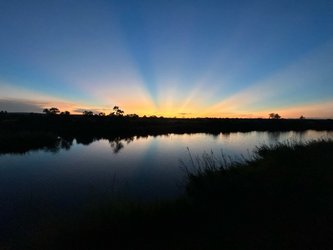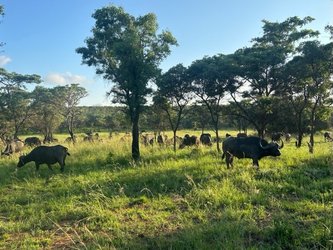Exciting news from the collaborators at the Waterberg Research Support Centre! They have just completed the latest check on our camera traps distributed across 10 reserves in the Waterberg. This initiative is part of our research into the impact of large herbivores on plant diversity and vegetation structure.
Dive into their work on the ECONOVO project with this engaging video report: https://www.facebook.com/reel/377561585002611.
Credit: Waterberg Research Support Centre.
Few things in ecology are as fun and exhausting as fieldwork. At the same time, it is one of the most important parts of our work as ecologists, allowing us to explore beautiful but remote areas and collect data specifically tailored to our research questions. Our work in the Waterberg area in South Africa marked the beginning of a number of field campaigns as part of ECONOVO.
To investigate the effects of wild large herbivores (also known as megafauna) and their community composition (i.e. functional diversity and density) on a variety of ecosystem properties such as plant diversity and spatial heterogeneity, we established field sites in 10 different reserves in the Waterberg Biosphere Reserve. These reserves are mostly privately owned and host different megafauna communities - from no large herbivores at all to a nearly complete megafauna community including elephant, rhino and buffalo. Work in the reserves included plant diversity assessment (for graminoids, herbs and woody species), measurement of some simple plant functional traits and terrestrial laser scanning (LiDAR), which allows us to obtain a three-dimensional picture of vegetation structure.
Given my, well, let's call it limited knowledge of the flora of southern Africa and the considerable amount of work required to collect this data, we were fortunate to have the fantastic help of our two field assistants, Anika Oosthuizen and Caroline Makofane.
We began our work in the Lapalala Wilderness, the largest private protected area in the Waterberg Biosphere Reserve. As is so often the case with this type of venture, the first few days did not go as smoothly as hoped for. As it turned out, things seem to be much more feasible when planning at a desk in Denmark than in practice. Who would have thought... (ok, admittedly, everyone told me that, and it happens to me all the time, but we're not here to learn too fast, ok??). Luckily, a group of students who have been identifying plants as part of a large elephant exclosure experiment in the reserve since the beginning of the year also stayed at our camp and helped us get on track with our species identification.
After just over a week in Lapalala, we traveled to the nearby Jembisa Reserve, where we collected data not only in the main part of the reserve, which is inhabited by animals up to the weight of a giraffe, but also in an adjacent area where there have been no large mammals for almost thirty years (apart from the occasional kudu or warthog)Our further route took us to the stunning landscapes of Syringa Sands and the neighboring Quella farm, which we had to leave all too soon to continue our sampling in the Summerplace Game Reserve. Here we received help in the field from Margerie Aucamp of the Waterberg Research Support Center (WRSC). At this point it is probably timely to give a shout out to Marilize Greyling from the WRSC, who was invaluable in making contacts with all the landowners in advance and making it possible to use the Waterberg area as a field site in the first place. Thanks a lot, Marilize!
After having sampled 5 reserves by now, we were feeling a bit more relaxed, and the day-to-day business (which usually consisted of leaving for the field at 6-6:30am and staying out until 5pm, followed by the most popular task of all: data entry in the evening) was starting to feel almost routine and went much more smoothly than in the first week or two. Consequently, the next two reserves (Dabchick and Ant’s Farm) were quite fun and full of awesome observations.
However, too much routine gets boring, so we decided to add a little variety at the next location, the Kaingo Game Reserve. Here, Robert Buitenwerf (Rob) joined us in the field for a week to help us with sampling and to get a better overview of the field sites and the sampling protocol. In addition, Linda Willemse, who owns the reserve together with her husband and is remarkably good at identifying forbs, accompanied us in the field for several days.




Coincidentally, Elizabeth Le Roux was also in South Africa at the time, which gave us the unique opportunity for the three of us from Aarhus University to be on the same continent as our ECONOVO colleague from the University of Pretoria Londiwe Mokoena and our ECONOVO Associate Michelle Greve. As this is a rare occasion, we decided to all meet in Kaingo to discuss our work together and gain more insight into each other's projects. The result was two days that were really productive and a lot of fun!
While the others unfortunately had to leave after two nights, Rob was able to stay a little longer and accompanied us for a few days in our second to last reserve, Sweswebe. With the now four-person team, the work went so smoothly that we were able to spare a whole day to go back to Lapalala and collect more LiDAR data in the large elephant exclosure experiment.




Unfortunately, Rob also had to leave us at some point, so we were on our own again as we continued on to our final location, Marakele National Park. Marakele NP is also home to an almost complete guild of megafauna, but our sampling here focused on a recently acquired and still fenced area to include another site with almost no large herbivores in our dataset. At Marakele we were largely accompanied by Steven Khosa, research ecologist at SANparks, who was a fantastic help in the field and beyond!
Time flew by and when we finished sampling in Marakele, it was already the end of March. It has been almost two months of amazing sightings, fantastic people, exhausting work and invaluable experiences. A big thanks to everyone who made this possible. Now the necessary, but perhaps slightly less fun, task of data cleaning and analysis lies ahead. Stay tuned to hear about the results!